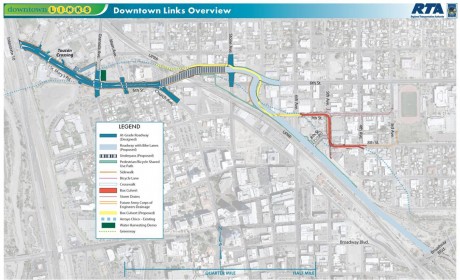The Regional Transportation Authority (RTA) recently completed a ‘value analysis’ for the Downtown Links project, a key roadway affecting downtown connectivity and access for all modes of transportation.
I don’t want to write about the particulars of the project itself; instead, I want to tell you about my experience with the value analysis process and what it means for bicyclists and other active/alternate transportation advocates.
A brief project overview first: Phases 3 and 4 of Downtown Links basically include a new roadway connecting the north end of Barraza-Aviation Parkway from Broadway up to 6th Street and then west, under the Union Pacific Railroad, to the soon to be widened St. Mary’s Road (see map). A multi-use path and land use planning are also included.
A value analysis is conducted on all RTA projects with a cost over $10 million. It is a week-long workshop with a detailed review by a team of 10 to 12 engineers, planners, and design professionals not associated with the proposed roadway design. The goal of the analysis is to develop alternate design proposals that save costs and/or enhance the value of the project. I was invited to be a part of the value analysis team for Downtown Links as a representative of the bicycling community and I was pleasantly surprised, both in what I learned and in what I was able to share with others.
I wasn’t sure what to expect going into this, but I fairly expected that in a cost-savings exercise, bicycle & pedestrian projects would be the first to get reduced or cut altogether. But after a week of working alongside civil and structural engineers, I now know that the big cost savings are often in structures — bridges and underpasses.
Our week together also confirmed that engineers live in a world of balancing competing constraints; costs, right-of-way space, clearances, soil conditions, traffic volume and speed, etc. Still, the engineers in the room were not only open to accommodating bicyclists and other modes of travel, they were often the ones initiating new ideas. I was encouraged that many ideas I’ve heard discussed for the downtown region, such as cycle tracks, road diets, bike counters, and roundabouts, were given a serious evaluation as part of the analysis and formally presented to the RTA Review Board.
Perhaps most surprising to me was how some of the out-of-town members of the team were unfamiliar with terms like road diet, sharrow, or cycle track. It reminded me that, while we’ve still got a long way to go, Tucson is definitely ahead of many places in the country.
So, after being locked (almost literally) in a room with engineers and planners for a week, I’m not so naïve to think that all our auto/bike/pedestrian conflicts are solved, but I am encouraged by the process. I hope that bicycle (and pedestrian) advocates will continue to be included as more projects go through the value analysis process. I believe it’s a great venue for engineers and alternate transportation folks to learn from each other and build good working relationships that will benefit the whole region.


Well, OK then. That’s encouraging. Thanks, Colby. I wonder if there is a similar approach with non-transportational land-use and development. I haven’t noticed one.
Sorry, but building a tunnel road, knocking down historic buildings, and splitting neighborhoods in half doesn’t help build anything good whether bike lanes/ .5 miles of paths are included or not. It’s the same with Grant road widening. The bike boulevards are a great idea, but the rest of the project doesn’t need to happen. It’s still based on a growth pattern that no longer exists – and that growth pattern is somehow based around many more cars existing for a significant amount of time. Car Head. Makes no sense. Don’t be fooled by engineers being nice. It’s the thing to do in these “green times”…
Sorry, blame for engineers is completely misplaced. The engineers aren’t the people that envision the projects. The engineers are the people that take some else’s idea and make that idea a reality. Contempt for the engineers just doing their jobs is stupid, especially when the engineers are plainly shown to be willing to listen to and accommodate cyclists. If you want to point fingers point them at the politicians, your neighbors, and possibly yourself.
Well said, PSI.
Tucson is a 12 year old child wearing adult clothes. This town has been so badly administered for so long, it’s still here only because of the good weather. I am pro road, and pro bike path. This town can’t seem to lay out roads that run straight, or even go thru. What’s up w/ the Alvernon & River road intersection? It’s backwards. As for finishing Aviation, connecting it to I-10, that should’ve been done decades ago. Many of you don’t know that Golf Links ended at Craycroft. To continue going west, you had to go north to another east – west street. Aviation was a miracle in this town, but only a half fulfilled one since it still doesn’t reach I-10. The problem w/ Tucson is they hurt the whole by coddling the parts. NIMBYs have too much power.
“Contempt for the engineers just doing their jobs is stupid, ” Why the pejorative to make the point?